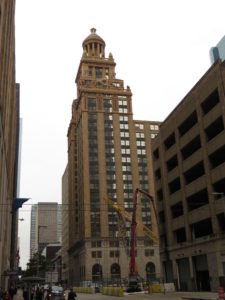
The Neils Esperson Building (Creative Commons photo attribution: photo courtesy Ken Lund)
One of Houston’s most influential businesswomen was born in the 1870s in Manhattan, Kansas, to Thomas and Hannah Marie (McFarland) Keenan. As a young woman, Mellie Keenan moved to Oklahoma, where she met and married Neils Esperson in El Reno on December 20, 1893. Neils was 36 and Mellie was 18. Mellie always called Neils, “Mr. Esperson.”
The Espersons went to Colorado in 1895, in response to stories about gold. While working long hours in the mines, Neils contracted tuberculosis. As a result of Neils’s illness, the Espersons moved back to Kansas so he could recuperate. Neils read everything he could about petroleum exploration during the two years it took to recover. The Espersons then moved to Texas where Neils hoped to make his fortune in the oil business.
In Texas, Neils made his fortune in the Humble Oil Field. With his earnings, he invested in real estate and other business ventures. He was one of the developers and financiers of the Houston Ship Channel.
One of Neils Esperson’s dreams was to build a movie theater in Downtown Houston with a skyscraper across the street. His dream went unfulfilled because while on a business trip to Chicago to meet with an architect for planning the theater, Neils died of a heart attack. He was 65 years old.
Mellie was 47 years old and left with massive land holdings and businesses in Texas as well as several other states. Her responsibility now was to manage these holdings. Her first endeavor was to build the theater Neils had dreamed about. She hired Chicago architect John Eberson to design the Majestic Theater in Downtown Houston at Rusk and Travis streets. The theater was completed in 1923, and the construction cost was $1 million. The theater was demolished in 1971.
After the completed construction and opening of the Majestic Theater, Mellie again hired Eberson to design a skyscraper across the street from the Majestic. This was another of Neils’s unfulfilled dreams. Mellie searched Europe and the U.S. to get ideas for building materials. Mellie intended the building to be a memorial for Neils. It cost $4 million to construct the 32-story skyscraper. Atop of the building was a temple-like structure with columns six stories tall. The top is adorned with urns and obelisks. Some people have referred to the building as the wedding cake building because of the top architecture. In 1938, Mellie had the building air-conditioned. It was one of the most prestigious buildings in Downtown Houston. The structure was called the Neils Esperson Building.
In 1938, Mellie again contacted Eberson to design a companion building, but told him that it was not to be taller than Neils’ building. She didn’t want to detract from Neils’s glory. The Mellie Esperson Building, 250 feet high and 19 stories, opened in 1941. The two buildings are two separate buildings, but most floors connect. It was the first large building in the southwest to be constructed with air-conditioning.
By 1940, Mellie could hardly see because of her cataracts. She would not seek medical treatment because of her Christian Scientist beliefs. Her sight was gone by 1941. With the help of a trusted companion, Mellie continued to manage the Esperson holdings.
During her career, Mellie was a member of the Houston Chamber of Commerce and supported the Museum of Fine Arts, the Little Theatre, and the Houston Symphony. She also had memberships in the Business and Professional Women’s Club, the city Federation of Women’s Clubs, and the French club. Mellie provided space for the draft board and the Soldiers Service Bureau during World War II.
Mellie Esperson married Harry Ewing Stewart in 1925. They established the Stewart Company which distributed farm and industrial equipment in the U.S. They divorced in 1931.
Mellie Keenan Esperson died in her Warwick Hotel (now Hotel Zaza) apartment on January 14, 1975. She was buried in Forest Park Cemetery next to her husband. Neils and Mellie had no children, so their $7.5 million estate was shared by ten close nieces and nephews.
Mellie believed that Houston had been both fair and good to the Espersons and that they owed much to the city.

